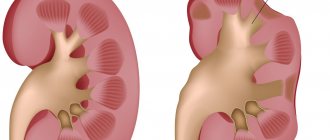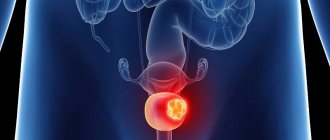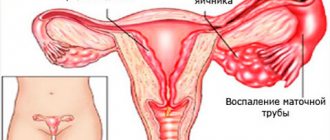A disease in which the intervals between menstruation last more than forty days is called oligomenorrhea. It is characterized by short-term, scanty bleeding during the critical period, usually with a short duration - about two to three days. The intervals between menstruation in this pathological condition last up to six months. Its symptoms are most often found in young girls and women before menopause. In general, this disorder affects up to 3% of women of reproductive age.
Second regulatory level
The hypothalamus is considered to be the main organ of the second regulatory level. It belongs to the neuroendocrine system. Consists of nerve cells that produce electrical signals and structures with endocrine function. The hypothalamus produces stimulants liberins and hormone-like substances statins, which inhibit the work of other endocrine glands. The function of this organ is regulated by the cortex and subcortex; it also responds to the quantitative content of hormones in the bloodstream. Liberins, which affect the gonads, are grouped under the single term gonadotropin-releasing hormone (GnRH). The production of this hormone is programmed in human genes, it has a pulsating nature, the substance is released into the blood at certain intervals. Active production of the hormone occurs within a few minutes, then a break lasts 1-3 hours. The hypothalamus is most influenced by estradiol, the level of which changes in different phases of the monthly cycle.
Third regulatory level
The third neuroendocrine regulatory level is the anterior pituitary gland. It produces a number of hormones:
- FSH (follicle stimulating) - is responsible for the growth of follicles and their maturation.
- LH (luteinizing hormone) – stimulates the synthesis of progesterone.
- Prolactin - affects the functionality of the corpus luteum, activates the production of progesterone by this temporary secretory gland.
- TSH (thyroid-stimulating), STH (somatotropic) and ACTH (adrenocorticotropic) - affects the production of hormones by the thyroid gland, adrenal glands, and stimulate bone growth.
Women have regular periods only when the amount of hormones synthesized by the pituitary gland is balanced and corresponds to the norm. In case of violations, cycle disruptions such as dysmenorrhea, oligomenorrhea or amenorrhea occur.
1.General information
Oligomenorrhea is a kind of gynecological syndrome, the main distinguishing features of which are abnormally long intervals between menstruation, the scarcity of the latter and their short duration. In some sources, oligomenorrhea is called a disease, but it should be emphasized that this is precisely a syndrome, i.e. a stable, recurring set of symptoms recognized by specialists as a single whole, which, however, can develop under the influence of very different reasons or against the background of various diseases.
Medical and statistical data regarding oligomenorrhea are contradictory, but most sources determine the frequency of occurrence in the range of 1.5-3% of the total population of menstruating women.
A must read! Help with treatment and hospitalization!
Fourth regulatory level
The fourth level includes peripheral endocrine organs - adrenal glands, thyroid gland, ovaries. The latter play a key role in this chain. Inside the ovaries, the follicle with the egg matures and increases in size, estrogens and other sex hormones are produced, and the corpus luteum is formed in the second half of the cycle.
Ovarian sex hormones have a regulatory effect not only on the reproductive organs. They also affect other systems, because many tissues have receptors for substances produced by the ovaries. Along with aminopeptides, insulin, glucagon, they act on the entire body.
Fifth regulatory level
The fifth level includes organs that respond to the effects of hormones. It includes the vagina, uterus, tubes and mammary glands. The uterus changes especially strongly. The endometrium is transformed under the influence of hormones in various phases of the cycle. It goes through the stage of cell proliferation, secretory activity and rejection (at this point menstruation begins). The normal passage of each phase is associated both with hormonal levels and with the functioning of receptors in the mucous layer.
The principle of operation of the five-level axis, including the hypothalamus, pituitary gland and ovaries, is based on direct and feedback with the participation of various groups of receptors. The system ensures the normal functioning of the reproductive organs.
Direct communication is a chain in which the hypothalamus acts on the pituitary gland, which triggers the process of hormone production by the ovaries. By inverse we mean the dependence of the functional activity of the hypothalamus with the pituitary gland on the amount of sex hormones in the bloodstream.
The function of the hypothalamic-pituitary-ovarian system can be judged by the regularity of the monthly cycle. This is one of the main objective indicators reflecting her condition. The frequency of menstruation, its duration, the amount of blood lost, etc. are assessed. A woman’s fertility largely depends on the normal functioning of all parts.
Oligomenorrhea, like other changes in the cycle, occurs when one of the organs of the hypothalamic-pituitary-ovarian system malfunctions, or as a result of a disruption in their interaction.
Symptomatic therapy
In cases where rare periods are associated with physiological hormonal changes, treatment is not prescribed. Such patients are advised to undergo constant monitoring by a gynecologist. It is important to exclude all provoking factors - stress, physical fatigue. It is especially important for teenage girls and young girls to maintain a balanced diet of calories and vitamins. Specific drug therapy is prescribed only by a specialist after completing a comprehensive examination and identifying the disease that caused the prolongation of the intermenstrual interval.
Why does oligomenorrhea develop?
Oligomenorrhea can be physiological or pathological. Physiological oligomenorrhea is typical for adolescents, when the cycle is not yet fully established, or for women during menopause, when fertility is fading. In young girls, periods should become regular over time, but in older girls they stop altogether.
The main types of pathological amenorrhea:
1. Primary. Such oligomenorrhea is observed in adolescents; at first it is perceived as physiological. But 1.5-2 years after menarche, the cycle is still not established. In this case, disturbances in the hypothalamic-pituitary system and failures of neuroendocrine regulation are observed. At first, they are associated with the immaturity of the body and are relatively easy to correct. Upon reaching childbearing age, they become more resilient.
2. Secondary. Signs of such oligomenorrhea occur in patients of any age, after a period with an established and regular menstrual cycle.
The cause of oligomenorrhea is disruption at any level of neurohumoral regulation. This is easy to understand by carefully studying its features. Most often, the monthly cycle is disrupted in the following situations:
- Injuries to the head and skull that lead to anatomical changes in the brain, tumors of the pituitary gland or hypothalamus, Cushing's syndrome and disease.
- Constant stress, nervous tension, family problems, etc.
- Hard physical work, change of climate region or time zone.
- Neuroinfection, meningitis, encephalitis, infectious diseases complicated by these conditions.
- Endocrine pathology (hypothyroidism, disorders in the islets of Langerhans, neoplasms in the adrenal glands, features of menopause, severe PMS).
- Hereditary problems in the reproductive organs.
- Congenital anomalies of the genitals.
- Metabolic disorders due to excess weight, sudden weight loss, poor diet, underweight for a long period of time.
- Long-term use of estrogen-based birth control, opiates, the antiemetic drug metoclopramide, hallucinogens, and some other drugs. Incorrect long-term use of glucocorticosteroids.
- Ovarian pathology (single cysts or polycystic disease, neoplasms).
- Frequent infections in childhood and adults, foci of chronic inflammation, changes in the structure of the endometrium that arise after inflammatory pathologies, uterine tumors, endometriosis, genital surgeries, injuries, artificial terminations of pregnancy, etc.
- In rare cases, oligomenorrhea develops with chronic pathology of the liver and heart.
The International Classification of Diseases (ICD-10) also takes into account unspecified oligomenorrhea. It is classified as a disease of the female genitourinary system of a non-inflammatory nature. This category includes oligomenorrhea, which develops as a result of exhaustion, dysgenesis, and severe inhibition of ovarian function. Sometimes the cycle changes due to an autoimmune process, as a result of which one’s own immunocompetent cells begin to attack and destroy ovarian tissue, as well as as a result of lesions of unknown etiology.
Kinds
Oligomenorrhea is a particular manifestation of hypomenstrual syndrome, which is a functional disorder. Depending on the main causative factor that led to the pathological condition and the time of primary manifestation, 2 types of disorders are distinguished:
- Primary amenorrhea is usually of congenital origin and appears during the formation of the menstrual cycle (menarche) in teenage girls.
- Secondary amenorrhea - develops as a result of exposure to various provoking factors in women of reproductive age after a certain time after the formation of a normal menstrual cycle.
Today, the pathological condition is registered quite often (2-3% of young women of reproductive age) and is one of the main causes of infertility.
How does oligomenorrhea manifest?
In women, first of all, the cycle lengthens, becomes irregular, the duration of menstruation is shortened to 1-2 days, and bleeding is scanty. These symptoms are accompanied by rapid weight gain, up to obesity (80% of cases), acne not only on the face, but also on the chest, back, increased activity of the sebaceous glands, enlarged skin pores, and the appearance of stretch marks (striae). A fourth of the patients exhibited hirsutism (male type of hair growth).
In some women, especially when oligomenorrhea appears at a very young age, the physique takes on masculine features (broad shoulders, narrow pelvis), their libido decreases, headaches and dizziness appear, the pressure becomes unstable, with a tendency to hypertension and a large difference between systolic and diastolic. Autonomic disorders are also characteristic - poor sleep, changes in appetite, irritability, mental lability, sweating.
Diagnosis of pathology
It is not difficult to diagnose oligomenorrhea; it is important to find its causes. The doctor relies on the collected medical history, examination (general and special gynecological), assessment of the state of the mental sphere, and the results of additional examinations.
Patients are recommended to measure their basal temperature over several months and draw up a schedule; they are prescribed ultrasound, CT and MRI of the brain, pelvis and retroperitoneum. Be sure to examine the hormones that are produced in the pituitary gland (prolactin, follicle-stimulating and luteinizing), ovaries and adrenal glands (progesterone, estradiol, testosterone). The level of glucose, cholesterol in the blood, and 17-ketosteroids in the urine is determined. These tests evaluate the functioning of the adrenal glands and the endocrine function of the pancreas.
Treatment of the disease
Treatment of oligomenorrhea begins after determining the cause; only correction of the underlying disease can get rid of the syndrome. To stimulate ovulation, clomiphene or gonadotropic drugs are used, they are prescribed according to a specific regimen. Birth control pills, utrozhestan, parlodel and other similar medications are also used.
Be sure to develop the right diet for the patient; if necessary, prescribe herbal sedatives, and in some cases even chemical antidepressants. Physiotherapy gives good results. If the cause of oligomenorrhea is a tumor of the pituitary gland, hypothalamus or other parts of the brain, surgery is prescribed (if possible), after which chemotherapy and radiation may be necessary.
If functional disorders of neuroendocrine regulation are identified and treated in time, the menstrual cycle and reproductive function can be completely restored. When the diagnosis is made too late, therapeutic measures are ineffective. Persistent changes occur in the genitals, which leads to infertility and other problems.
Description
Oligomenorrhea is classified as a menstrual disorder. Its duration with this violation exceeds forty days. The intervals between menstruation increase or the duration of menstruation decreases. Oligomenorrhea is accompanied by a decrease in the volume of bloody discharge.
The duration of menstruation is also quite unstable. It varies from several hours to two days. There may be constant pain and discomfort in the lower abdomen. Oligomenorrhea is formed due to overload, hormonal changes, and pathology of the genital organs.
Often this disorder is combined with other disorders - scanty periods, called hypomenorrhea or rare periods, called spaniomenorrhea. Such changes in the cycle often become harbingers of amenorrhea - absence of menstruation.
Is pregnancy possible with oligomenorrhea?
The chance of getting pregnant and carrying a child with oligomenorrhea depends most on its causes. Conception is impossible if a woman does not ovulate. Problems with embryo implantation arise when cyclic processes in the endometrium are disrupted. With infantilism, which also becomes a common cause of this menstrual disorder, fertility is affected by the degree of underdevelopment of the uterus, the activity of the ovaries, and the presence of concomitant diseases.
In 1985, the WHO collected and published data that 14.7% of infertility cases are due to oligomenorrhea. Among menstrual disorders that interfere with conception, this pathology accounts for 41.6%. Only 20% of patients with oligomenorrhea can become pregnant on their own.
Complications, prognosis and prevention
The main complication of secondary oligomenorrhea, which is most feared, is infertility. According to statistics, in approximately 40% of cases a woman is not able to conceive or bear a child precisely because of the presence of secondary type oligomenorrhea. Also, hormonal imbalance in general negatively affects the body, increasing the likelihood of developing cancer of the reproductive system.
With timely initiation of treatment, the prognosis for secondary oligomenorrhea is favorable. A significant number of women, under the supervision of a doctor, manage to normalize hormone levels and regulate the menstrual cycle.
Prevention of the secondary form of oligomenorrhea is based on maintaining a healthy lifestyle, timely treatment of identified diseases, and regular preventive examinations with a gynecologist.










